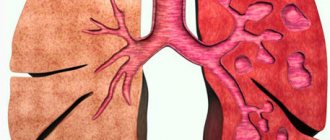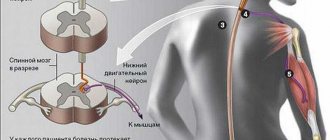general information
Ebola virus disease ( EVD , Ebola hemorrhagic fever ) is a fatal disease with periodic outbreaks that occur primarily on the African continent. EVD most often affects humans and non-human primates (such as monkeys, gorillas, and chimpanzees). The disease is caused by infection with a group of viruses within the genus Ebolavirus (Ebolavirus):
- Ebola virus (species Ebolavirus Zaire)
- Sudan virus (a type of Sudan Ebolavirus)
- Thai Forest virus (species Thai Forest Ebolavirus, formerly Ivory Coast Ebolavirus)
- Bundibugyo virus (species of Ebolavirus Bundibugyo)
- Reston virus (Ebolavirus Reston species)
- Bombali virus (Ebolavirus Bombali species)
Of these, only four pathogens (Zaire, Sudan, Thai Forest and Bundibugyo viruses) are known to cause disease in humans. The Reston virus is known to cause disease in non-human primates and pigs, but not in humans. It is unknown whether the Bombali virus, recently discovered in bats, causes illness in animals or humans.
The Ebola virus was first discovered in 1976 near the Ebola River in what is now the Democratic Republic of Congo. Since then, the virus has been infecting people from time to time, leading to outbreaks in several African countries. Scientists don't know where the Ebola virus came from. However, based on the nature of similar viruses, they believe that the virus is carried by animals, with the most likely source being bats or non-human primates (chimpanzees, monkeys, gorillas, etc.). Infected animals carrying the virus can transmit it to other animals and people.
The virus initially spreads to people through direct contact with blood, body fluids and animal tissues. The Ebola virus then spreads to other people through direct contact with the body fluids of a person who is sick or has died from Ebola. This can happen when a person touches these infected fluids (or objects contaminated with them) and the virus enters through broken skin or mucous membranes into the eyes, nose or mouth. People can become infected with the virus through sexual contact with someone who has Ebola, or after recovering from EVD. The virus can persist in certain body fluids, such as semen, after recovery.
After recovery, survivors may experience side effects such as fatigue, muscle pain, vision problems, and stomach pain.
Pathogenesis and pathological anatomy
When it enters the human body, the virus penetrates through the bloodstream into the parenchymal organs, where it multiplies, and then passes back into the blood. The development of hemorrhages is facilitated by thrombocytopenia and a decrease in the content of factors in the blood that determine its coagulation (see Blood coagulation system).
In those who died from Ebola hemorrhagic fever, widespread dystrophic and focal necrotic changes in the liver, necrotic changes in the red pulp of the spleen and proliferation of reticuloendothelial cells are found. Necrotic changes are also observed in the pancreas, adrenal glands, pituitary gland, thyroid gland, testes and ovaries. Multiple hemorrhages are detected in the brain, changes in glial elements of both a proliferative (appearance of glial nodules and rosettes) and degenerative (pyknosis and rhexis of nuclei) nature are noted. A distinctive feature of the pathological process is thrombosis of small vessels and the development of hemorrhages.
Immunity to Ebola hemorrhagic fever has not been well studied.
Symptoms of Ebola fever
The incubation period, that is, the time interval from the moment of infection with the virus to the onset of symptoms, is 2–21 days after exposure to the virus, on average from 8 to 10 days. A person infected with Ebola cannot spread the disease until symptoms appear. The course of the disease usually progresses from "dry" symptoms at first (such as fever, aches and fatigue) and then progresses to "wet" symptoms (such as diarrhea and vomiting) as the person becomes sicker.
Primary signs and symptoms of Ebola may come on suddenly and often include some or more of the following:
- fever;
- weakness and fatigue;
- muscle and joint pain;
- Strong headache;
- a sore throat.
This is followed by symptoms:
- redness of the eyes;
- vomit;
- diarrhea;
- skin rash;
- impaired renal and liver function;
- in rare cases, both internal and external bleeding (for example, bleeding from the gums, blood in the stool).
Doctors' forecasts
Despite high mortality and disease transmission, medical experts' forecasts regarding the size of the epidemic are favorable.
One of the inherent properties of the Ebola virus is that it is not airborne like the flu. This quality prevents the spread of the epidemic over large areas, which gives humanity an additional benefit in the fight against this deadly infection.
Also during the incubation period, when there are no signs of disease, the person is usually not contagious, and when disease becomes apparent, over time the contagious patient can be identified and isolated.
Nevertheless, Ebola was and remains one of the most serious infectious diseases. Despite all precautions, no one is safe from infection. The number of infected people has now exceeded 3,000 people and, according to medical forecasts, could reach 1.5 million.
How is the virus transmitted to humans?
Scientists believe that people initially become infected with the Ebola virus through contact with an infected animal, such as a bat or monkey. This is called a side effect. The pathogen then spreads from person to person, potentially affecting large numbers of people.
The virus is spread by direct contact (for example, broken skin or mucous membranes of the eyes, nose or mouth) through:
- Blood or body fluid (urine, saliva, sweat, feces, vomit, breast milk, and semen) of a person who is sick or has died from an illness.
- Items (such as clothing, bedding, needles, and medical equipment) contaminated with body fluids from a person who is sick or has died from a disease.
- Infected bats or non-human primates (such as monkeys and chimpanzees...).
- Sperm from a man who has recovered from EVD (through oral, vaginal or anal sex). The virus may remain in certain body fluids (including semen) of a patient even if he no longer has symptoms of severe illness. There is no evidence that Ebola can be spread through sexual contact or other contact with vaginal fluids of a woman who has had Ebola.
Additionally, the Ebola virus is not known to be transmitted through food. However, in some parts of the world, the disease can be spread through the handling and consumption of bushmeat or the hunting of bushmeat infected with the virus. There is no evidence that mosquitoes or other insects can transmit the Ebola virus.
Risks
- Health care workers who do not use proper infection control when caring for patients with Ebola, as well as family members and friends who are in close contact with patients with the disease, are at greatest risk of becoming ill. The disease can spread when people come into contact with infected blood or body fluids.
- Ebola poses little risk to travelers or the general public who have been in close contact (within 3 feet or 1 meter) of someone who has Ebola.
Broken thermos
The nearest professional doctor, Dr. Ngoy, worked 100 kilometers away, in the county center - the village of Bumba. On September 16 he was called to the mission. After examining 17 patients, he stated that this was a previously unknown disease. They didn't believe him. Leading epidemiologists arrived from the country's capital, Kinshasa, and diagnosed typhoid fever. The sick nurse was transported to Kinshasa, under the supervision of experienced doctors. When she infected the medical staff already in the capital, a sample of her blood was taken to the Tropical Institute in Antwerp.
They were transported in an ordinary thermos, which on the way was properly pressed against something hard, so that one of the two test tubes broke. Melt water with blood soaked the note from the doctor in the thermos describing the clinical picture. The head of the infection research laboratory, Stefan Pattin, ordered his employees to take this note with gloves - after all, we are talking about an infection.
But at the same time, young doctors Peter Piot and Guido van der Groyn, who were cultivating viruses, worked without masks and in cotton gowns. Moreover, when they handed the test tube with the microscopy material to their boss, he immediately dropped it, so that the medium splashed on the assistant’s shoes.
Virus persistence
The virus may remain in areas of the body that are immunologically privileged sites after acute infection. These are places where viruses and pathogens, such as the Ebola virus, are protected from the immune system even after they have been cleared from other parts of the body. These areas include the testicles, the inside of the eyes, the placenta, and the central nervous system, especially the cerebrospinal fluid. Whether the virus is in these parts of the body and how long they are there depends on the survivor. Scientists are now studying how long the virus remains in these body fluids among Ebola survivors.
During an outbreak, the virus can spread rapidly in health care settings (such as clinics or hospitals). Clinicians and other medical personnel providing care should use specialized, preferably disposable, medical equipment. Proper cleaning and disposal of instruments such as needles and syringes is very important. If instruments are disposable, they must be sterilized before reuse.
Damn hospital
Most of the victims were those who visited the outpatient clinic there. Among them, women of childbearing age predominated. Then everyone who came into close contact with them fell ill and died with terrible bleeding, but the source was the hospital. The first to guess was Dr. Masamba, a sanitary inspector from Legala, who knew his people well. Africans do not trust pills and potions, considering them weak, but for them an injection with a syringe is “dava,” a real effective medicine. Pregnant women often asked missionary nurses to inject them with something, and they injected them with vitamin B and calcium gluconate. There is no harm, but it invigorates, which pregnant women, exhausted from hard work, really liked.
Peter Piot went to the sealed mission building to look at the treatment room. The rubber lids of the jars containing solutions were punctured by syringe needles. Some jars were completely plugged with cotton wool. And then a terrible suspicion dawned on the Belgians. Every evening they communicated with the surviving sisters of the mission, delighting them with conversation in their native Flemish dialect over a glass of vermouth. And when the nuns' tongues were loosened, they were asked how exactly they administered the injections.
Sister Genoveva Giesebrechts readily shared that they boiled their glass syringes in the morning, along with obstetric instruments. Then they injected incoming patients with the same syringe all day, changing needles and washing the syringe after each injection with clean water. After all, that's enough, isn't it?
Diagnostics
It can be difficult to distinguish Ebola disease from other infectious diseases such as malaria, typhoid fever and meningitis. The following tests are done to confirm that symptoms are caused by the Ebola virus:
- enzyme-linked antibody capture immunosorbent assay (ELISA);
- antigen detection tests;
- serum neutralization reaction;
- reverse transcriptase polymerase chain reaction (RT-PCR);
- electron microscopy;
- virus isolation in cell cultures.
When selecting diagnostic tests, physicians consider technical specifications, disease incidence and prevalence rates, and the social and health implications of the test results. Diagnostic tests that have undergone independent and international evaluation are strongly recommended for use.
Currently recommended studies include the following:
- Automated and semi-automated nucleic acid amplification tests (NAT) for routine diagnostics.
- Rapid antigen detection tests for use in remote areas without access to NAT. These tests are recommended for screening purposes as part of surveillance, but reactive tests must be confirmed by NAT.
Samples taken from patients pose an extremely high biohazard; laboratory testing of non-inactivated samples is carried out under conditions of maximum biological isolation. During national and international shipments, all biological samples are placed in triple packaging systems.
Help for people who have recovered from EVD
Individuals who have recovered from Ebola experience a range of medical complications, including mental health problems. The Ebola virus can survive for a long time in some body fluids, including semen. Ebola survivors require comprehensive support to address their medical and psychosocial needs and to minimize the risk of further transmission of the Ebola virus. To meet these needs, it is advisable to establish a special program to provide assistance to Ebola survivors.
For more information, see the Clinical Care Guide for Survivors of Ebola Virus Disease.
The Ebola virus is known to persist in immune-privileged parts of the body of some people who have had Ebola virus disease. These body parts include the testes, the inside of the eyes, and the central nervous system. In women infected during pregnancy, the virus persists in the placenta, amniotic fluid and embryo. In women infected while breastfeeding, the virus may persist in breast milk.
Recurrence of symptoms in a person who has had EVD due to increased replication of the virus in a specific part of the body has been documented, although rare. The reasons for this phenomenon have not been fully elucidated.
Viral resistance studies suggest that a small percentage of recovered individuals may test positive for Ebola virus by reverse transcriptase polymerase chain reaction (RT-PCR) of some body fluids for more than 9 months.
Additional surveillance data and further research are needed regarding the risks associated with sexual transmission, and in particular regarding the presence of viable and transmissible virus in seminal fluid over the long term. Based on the available evidence, WHO makes the following interim recommendations:
- All Ebola survivors and their sexual partners should receive counseling on safe sex practices until a double-negative semen test is obtained. Survivors should be provided with condoms.
- Male Ebola survivors should be offered semen testing three months after illness onset and then, if the test is positive, every month until the semen is tested twice negative for the virus by RT-PCR, with a week interval between tests.
- Ebola survivors and their sexual partners should
- Once tested negative, Ebola survivors can safely resume normal sex life without fear of transmitting the virus.
- Based on an analysis of additional evidence from ongoing research and discussions by the WHO Advisory Group on the Response to Ebola Virus Disease, WHO recommends that men who have had Ebola virus disease practice safe sex and good hygiene for 12 months after the onset of symptoms or until they test their semen twice negative for Ebola virus.
- Until a semen test test negative twice for Ebola virus, survivors of the disease should practice good hand and personal hygiene by washing promptly and thoroughly with soap and water after any physical contact with semen, including after masturbation. During this period, you should be careful when handling used condoms and disposing of them safely to avoid contact with seminal fluid.
- All survivors, their partners and families should be treated with compassion and respect for their dignity.
Interim recommendations regarding sexual transmission of Ebola virus disease
Ebola treatment
Symptoms of Ebola virus disease should be treated as soon as they appear. When applied early, basic interventions can significantly improve the chances of survival. These include:
- Providing fluids and electrolytes (body salts) by infusion into a vein (intravenously).
- Offering oxygen therapy to maintain oxygen status.
- Using medications to maintain blood pressure, reduce vomiting and diarrhea, and control fever and pain.
- Treat other infections if they occur.
Antiviral drugs
There is currently no antiviral drug licensed for the treatment of EVD in humans.
During the 2021 outbreak in eastern Democratic Republic of Congo, four investigational drugs were initially available to treat patients with confirmed Ebola. Two of these drugs, called Regeneron (REGN-EB3) and mAb114, had much longer overall survival rates. These two antiviral drugs currently continue to be used for patients with confirmed Ebola.
The drugs being developed to treat Ebola work by stopping the virus from replicating itself.
WHO activities
WHO aims to prevent Ebola outbreaks by providing surveillance for Ebola virus disease and supporting countries at risk to develop preparedness plans. The Ebola and Marburg fever epidemic: preparedness, prevention, control and assessment provides general guidance for managing outbreaks of Ebola and Marburg virus disease.
- Ebola and Marburg virus disease epidemic: preparedness, prevention, control and assessment - in English
WHO's response to an outbreak includes assistance in areas such as community engagement, case identification, contact tracing, vaccinations, case management, laboratory services, infection control, logistics and training, and also assistance in organizing a dignified burial of the dead.
WHO has prepared detailed recommendations for the prevention and control of Ebola virus infection:
- Infection prevention and control guidance for care of patients with suspected or confirmed filovirus hemorrhagic fever in health care settings, with a focus on Ebola - in English
Prevention
In Russia, the disease caused by the Ebola virus (EVD) has never appeared; there were about 40 suspicions, but none of them were confirmed.
EVD is most common in parts of sub-Saharan Africa, with rare outbreaks in humans. In these areas, the Ebola virus is believed to circulate at low rates in certain animal populations (enzootic). Sometimes people get sick from Ebola after coming into contact with these infected animals, which can lead to outbreaks when the virus spreads between people.
Brief historical information
The disease was first registered and described in the Ebola region (Zaire) in 1976. At the same time, the pathogen was isolated from the blood of one of the deceased patients. Outbreaks of infection in Zaire and Sudan in 1976-1979, in Zaire in 1994-1995, numbering in the hundreds of cases, were accompanied by high mortality (from 53% to 88%). In 1996, an outbreak of Ebola fever was reported in Gabon. Data from retrospective serological screening of the population suggest that epidemics of the disease were noted in 1960-1965. in Nigeria, Senegal, Ethiopia.
Ebola vaccine
There is currently no vaccine licensed by the Food and Drug Administration to protect people against the Ebola virus.
Several investigational vaccines to prevent Ebola virus infection are in development and in clinical trials.
An experimental vaccine, called rVSV-ZEBOV, was found to be highly effective against the virus in a study conducted by the World Health Organization (WHO) and other international partners in Guinea in 2015. Although still experimental, it has been approved for emergency use in the 2021 Ebola outbreak in the Democratic Republic of Congo (DRC). This vaccine has been shown to be safe and protective against Ebolavirus Zaire.
A second investigational vaccine will be introduced in 2021 in the DRC in accordance with the research protocol. The second vaccine is a two-dose regimen with an initial dose followed by a second “booster” dose 56 days later. The second vaccine is also designed to protect against Ebolavirus Zaire.
Vaccine design
Currently, there is no specific treatment and prevention of Ebola fever, in particular, antiviral drugs and vaccines approved by regulators according to the standard procedure. So far we are talking only about symptomatic therapy and experimental drugs. The reason for this is clear: Ebola fever is a relatively “young” disease, which until 2014 was not widespread and did not pose a particular threat to countries outside the African continent, where all the leading research centers are located.
Individual companies carried out their own developments, but previously they were not supported by adequate government funding. As a result, by 2014, there were no drugs registered for medical use against Ebola in the arsenal of doctors. What happened this year spurred governments of different countries to take active organizational measures and finance projects to create effective means against the spread of the deadly virus.
According to Minister Veronika Skvortsova, the Russian Federation is currently developing three vaccines for humans against the Ebola fever pathogen, two of them using genetic engineering. But they still have to go through the clinical trial stage, so they will be ready no earlier than in six months. The principle of genetically engineered vaccines is as follows: make a molecular construct that is not the Ebola virus, but at the same time represents its antigen.
Thus, the vaccine will not cause illness, but will develop a complex of immune reactions that will protect a person from a deadly pathogen. Russian virologists are ready to conduct tests of drugs supposedly effective against this virus, as well as vaccines being developed in other countries. In particular, there have been reports in the press that specialists from the State Scientific Clinical Center “Vector” plan to begin in October a study of one of the well-known antiviral drugs indicated for use in viral hepatitis for activity against the Ebola virus.
Complications of Ebola
Ebola hemorrhagic fever often has many complications; organ failure, severe bleeding, jaundice, delirium, shock, convulsions, coma and death (about 50%-100% of infected patients). Those patients lucky enough to survive Ebola may still have complications lasting many months.
Survivors may experience:
- weakness;
- fatigue;
- sensory changes;
- headache;
- hair loss;
- hepatitis;
- inflammation of organs (for example, testicles and eyes).
Diagnostic methods
For our country, Ebola fever remains an extremely rare disease, so diagnostic tests are performed in specialized virology laboratories that adhere to the highest biosafety standards. The virus is isolated from any biological fluids of the patient, after which it is transferred to cell cultures, PCR tests are performed, and biopsies of the skin and internal organs are examined using an electron microscope. In addition, a general analysis and blood coagulogram are performed to identify characteristic changes.
Diet
Dietary nutrition is prescribed that corresponds to Table No. 4 according to Pevzner, which provides a diet containing the physiological norm of protein with a limitation of fats and carbohydrates. All products that enhance the processes of rotting/fermentation in the intestines and the secretion of the digestive organs are excluded: liquid, semi-liquid and mashed dishes, steamed/boiled in water are indicated. The power mode is fractional. During the recovery period, a diet with a high content of animal protein is indicated.
Epidemiological surveillance
The implementation of the International Epidemiological Surveillance System for Contagious Hemorrhagic Fever is intended to provide the necessary information for the timely and complete implementation of preventive measures. Due to the difficulty in some cases of carrying out full laboratory diagnosis of diseases, clinical manifestations become of utmost importance. Taking into account the WHO concept, all countries are required to immediately notify headquarters of single or group severe diseases characterized by acute hemorrhagic fever syndrome. According to the definition of the WHO Expert Committee, a patient with Lassa, Marburg and Ebola fever is a person with a febrile illness accompanied by one or more of the following signs: virus isolation, a 4-fold increase in antibody titers to the virus 1-2 weeks after collection. With Lassa fever, IgG titers upon admission are at least 1:512 and positive IgM titers; for Marburg and Ebola fevers, the IgM content is 1:8 and higher, IgG - 1:64 in the RIF.
The last flash
Over the course of thirty years, the epidemic periodically arose and subsided again, taking with it a significant number of victims. The Ebola virus has managed to cause thousands of deaths across Central Africa. If the epidemics of previous years did not affect such a significant area and population, then the last outbreak in the summer of 2014 claimed more than 900 lives out of 1,700 infected. Of course, if we take into account the population of the entire planet, this number does not look so terrifying. But for small communities and African villages this became a real pestilence. Despite all the efforts of Nigerian doctors to contain the spread of the virus, new cases of infection became known almost every day, and its geography expanded to Côte d'Ivoire and Sierra Leone.











